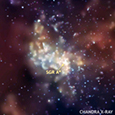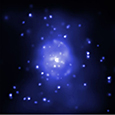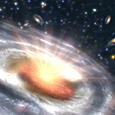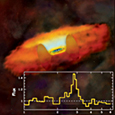Cloning in biology is the process of producing populations of genetically-identical individuals that occurs in nature when organisms such as bacteria, insects or plants reproduce asexually. Cloning in biotechnology refers to processes used to create copies of DNA fragments (molecular cloning), cells (cell cloning), or organisms. More generally, the term refers to the production of multiple copies of a product such as digital media or software.
Contents |
Etymology
The term clone is derived from κλών, the Greek word for "twig, branch", referring to the process whereby a new plant can be created from a twig. In horticulture, the spelling clon was used until the twentieth century; the final e came into use to indicate the vowel is a "long o" instead of a "short o"[citation needed]. Since the term entered the popular lexicon in a more general context, the spelling clone has been used exclusively.
Molecular cloning
| This section is missing citations or needs footnotes. Using inline citations helps guard against copyright violations and factual inaccuracies. (February 2008) |
Molecular cloning refers to the process of making multiple copies of a defined DNA sequence. Cloning is frequently used to amplify DNA fragments containing whole genes, but it can also be used to amplify any DNA sequence such as promoters, non-coding sequences and randomly fragmented DNA. It is used in a wide array of biological experiments and practical applications ranging from genetic fingerprinting to large scale protein production. Occasionally, the term cloning is misleadingly used to refer to the identification of the chromosomal location of a gene associated with a particular phenotype of interest, such as in positional cloning. In practice, localization of the gene to a chromosome or genomic region does not necessarily enable one to isolate or amplify the relevant genomic sequence.
In practice, in order to amplify any DNA sequence in a living organism, that sequence must be linked to an origin of replication, which is a sequence of DNA capable of directing the propagation of itself and any linked sequence. However, a number of other features are needed and a variety of specialised cloning vectors (small piece of DNA into which a foreign DNA fragment can be inserted) exist that allow protein expression, tagging, single stranded RNA and DNA production and a host of other manipulations.
Cloning of any DNA fragment essentially involves four steps [1]
- fragmentation - breaking apart a strand of DNA
- ligation - gluing together pieces of DNA in a desired sequence
- transfection - inserting the newly formed pieces of DNA into cells
- screening/selection - selecting out the cells that were successfully transfected with the new DNA
Although these steps are invariable among cloning procedures a number of alternative routes can be selected, these are summarized as a cloning strategy’.
Initially, the DNA of interest needs to be isolated to provide a DNA segment of suitable size. Subsequently, a ligation procedure is used where the amplified fragment is inserted into a vector (piece of DNA). The vector (which is frequently circular) is linearised using restriction enzymes, and incubated with the fragment of interest under appropriate conditions with an enzyme called DNA ligase. Following ligation the vector with the insert of interest is transfected into cells. A number of alternative techniques are available, such as chemical sensitivation of cells, electroporation and biolistics. Finally, the transfected cells are cultured. As the aforementioned procedures are of particularly low efficiency, there is a need to identify the cells that have been successfully transfected with the vector construct containing the desired insertion sequence in the required orientation. Modern cloning vectors include selectable antibiotic resistance markers, which allow only cells in which the vector has been transfected, to grow. Additionally, the cloning vectors may contain colour selection markers which provide blue/white screening (α-factor complementation) on X-gal medium. Nevertheless, these selection steps do not absolutely guarantee that the DNA insert is present in the cells obtained. Further investigation of the resulting colonies is required to confirm that cloning was successful. This may be accomplished by means of PCR, restriction fragment analysis and/or DNA sequencing.
Cellular cloning
Cloning a cell means to derive a population of cells from a single cell. In the case of unicellular organisms such as bacteria and yeast, this process is remarkably simple and essentially only requires the inoculation of the appropriate medium. However, in the case of cell cultures from multi-cellular organisms, cell cloning is an arduous task as these cells will not readily grow in standard media.
A useful tissue culture technique used to clone distinct lineages of cell lines involves the use of cloning rings (cylinders)[2]. According to this technique, a single-cell suspension of cells which have been exposed to a mutagenic agent or drug used to drive selection is plated at high dilution to create isolated colonies; each arising from a single and potentially clonally distinct cell. At an early growth stage when colonies consist of only a few of cells, sterile polystyrene rings (cloning rings), which have been dipped in grease are placed over an individual colony and a small amount of trypsin is added. Cloned cells are collected from inside the ring and transferred to a new vessel for further growth.
Cloning in stem cell research
Somatic cell nuclear transfer can also be used to create a clonal embryo. The most likely purpose for this is to produce embryos for use in research, particularly stem cell research. This process is also called "research cloning" or "therapeutic cloning." The goal is not to create cloned human beings, but rather to harvest stem cells that can be used to study human development and to potentially treat disease. While a clonal human blastocyst has been created, stem cell lines are yet to be isolated from a clonal source.[3]
Organism cloning
Organism cloning refers to the procedure of creating a new multicellular organism, genetically identical to another. In essence this form of cloning is an asexual method of reproduction, where fertilization or inter-gamete contact does not take place. Asexual reproduction is a naturally occurring phenomenon in many species, including most plants (see vegetative reproduction) and some insects.
Parthenogenesis
Clonal derivation exists in nature in some animal species and is referred to as parthenogenesis (reproduction of an organism by itself without a mate). An example is the "Little Fire Ant" (Wasmannia auropunctata), which is native to Central and South America but has spread throughout many tropical environments.
Reproductive cloning
Reproductive cloning uses "somatic cell nuclear transfer" (SCNT) to create animals that are genetically identical. This process entails the transfer of a nucleus from a donor adult cell (somatic cell) to an egg which has no nucleus. If the egg begins to divide normally it is transferred into the uterus of the surrogate mother.
Such clones are not strictly identical since the somatic cells may contain mutations in their nuclear DNA. Additionally, the mitochondria in the cytoplasm also contains DNA and during SCNT this DNA is wholly from the donor egg, thus the mitochondrial genome is not the same as that of the nucleus donor cell from which it was produced. This may have important implications for cross-species nuclear transfer in which nuclear-mitochondrial incompatibilities may lead to death.
Dolly the Sheep
Dolly (1996-07-05 – 2003-02-14), a Finn Dorsett ewe, was the first mammal to have been successfully cloned from an adult cell, though the first actual thing to be cloned, was a tadpole in 1952[1]. She was cloned at the Roslin Institute in Scotland and lived there until her death when she was six. On 2003-04-09 her stuffed remains were placed at Edinburgh's Royal Museum, part of the National Museums of Scotland.
Dolly was publicly significant because the effort showed that the genetic material from a specific adult cell, programmed to express only a distinct subset of its genes, could be reprogrammed to grow an entire new organism. Before this demonstration, there was no proof for the widely spread hypothesis that differentiated animal cells can give rise to entire new organisms.
Cloning Dolly the sheep had a low success rate per fertilized egg; she was born after 277 eggs were used to create 29 embryos, which only produced three lambs at birth, only one of which lived. Seventy calves have been created from 9,000 attempts and one third of them died young; Prometea took 328 attempts. Notably, although the first clones were frogs, no adult cloned frog has yet been produced from a somatic adult nucleus donor cell.
There were early claims that Dolly the Sheep had pathologies resembling accelerated aging. Scientists speculated that Dolly's death in 2003 was related to the shortening of telomeres, DNA-protein complexes that protect the end of linear chromosomes. However, other researchers, including Ian Wilmut who led the team that successfully cloned Dolly, argue that Dolly's early death due to respiratory infection was unrelated to deficiencies with the cloning process.
Species cloned
The modern cloning techniques involving nuclear transfer have been successfully performed on several species. Landmark experiments[clarification needed] in chronological order:
- Tadpole: (1952) Many scientists questioned whether cloning had actually occurred and unpublished experiments by other labs were not able to reproduce the reported results.[citation needed]
- Carp: (1963) In China, embryologist Tong Dizhou cloned a fish. He published the findings in a Chinese science journal which was never translated into English.[4]
- Mice: (1986) were the first successfully cloned mammal; Soviet scientists Chaylakhyan, Veprencev, Sviridova, and Nikitin had the mouse "Masha" cloned. Research was published in the magazine "Biofizika" volume ХХХII, issue 5 of 1987.[clarification needed][5]
- Sheep: (1996) From early embryonic cells by Steen Willadsen. Megan and Morag[citation needed] cloned from differentiated embryonic cells in June 1995 and Dolly the sheep from a somatic cell in 1997.[6]
- Rhesus Monkey: Tetra (female, January 2000) from embryo splitting[7][clarification needed]
- Gaur: (2001) was the first endangered species cloned.[8]
- Cattle: Alpha and Beta (males, 2001) and (2005) Brazil[9]
- Cat: CopyCat "CC" (female, late 2001), Little Nicky, 2004, was the first cat cloned for commercial reasons[citation needed]
- Mule: Idaho Gem, a john mule born 4 May 2003, was the first horse-family clone.[citation needed]
- Horse: Prometea, a Haflinger female born 28 May 2003, was the first horse clone.[citation needed]
Further information: List of animals that have been cloned
Human cloning
Human cloning is the creation of a genetically identical copy of an existing or previously existing human. The term is generally used to refer to artificial human cloning; human clones in the form of identical twins are commonplace, with their cloning occurring during the natural process of reproduction. There are two commonly discussed types of human cloning: therapeutic cloning and reproductive cloning. Therapeutic cloning involves cloning cells from an adult for use in medicine and is an active area of research: while reproductive cloning would involve making cloned human beings. Such reproductive cloning has not been performed and is illegal in many countries. A third type of cloning called replacement cloning is a theoretical possibility, and would be a combination of therapeutic and reproductive cloning. Replacement cloning would entail the replacement of an extensively damaged, failed, or failing body through cloning followed by whole or partial brain transplant.
The various forms of human cloning are controversial.[10] There have been numerous demands for all progress in the human cloning field to be halted. Some people and groups oppose therapeutic cloning, but most scientific, governmental and religious organizations oppose reproductive cloning. The American Association for the Advancement of Science (AAAS) and other scientific organizations have made public statements suggesting that human reproductive cloning be banned until safety issues are resolved [11]. Serious ethical concerns have been raised by the idea that it might be possible in the future to harvest organs from clones. Some people have considered the idea of growing organs separately from a human organism - in doing this, a new organ supply could be established without the moral implications of harvesting them from humans. Research is also being done on the idea of growing organs that are biologically acceptable to the human body inside of other organisms, such as pigs or cows, then transplanting them to humans, a form of xenotransplantation.
The first human hybrid human clone was created in November 1998, by American Cell Technologies.[12]. It was created from a man's leg cell, and a cow's egg whose DNA was removed. It was destroyed after 12 days. Since a normal embryo implants at 14 days, Dr Robert Lanza, ACT's director of tissue engineering, told the Daily Mail newspaper that the embryo could not be seen as a person before 14 days. While making an embryo, which may have resulted in complete human had it been allowed to come to term, according to ACT: "[ACT's] aim was 'therapeutic cloning' not 'reproductive cloning'"
On January, 2008, Wood and Andrew French, Stemagen's chief scientific officer in California, announced that they successfully created the first 5 mature human embryos using DNA from adult skin cells, aiming to provide a source of viable embryonic stem cells. Dr. Samuel Wood and a colleague donated skin cells, and DNA from those cells was transferred to human eggs. It is not clear if the embryos produced would have been capable of further development, but Dr. Wood stated that if that were possible, using the technology for reproductive cloning would be both unethical and illegal. The 5 cloned embryos, created in Stemagen Corporation lab, in La Jolla, were destroyed.Cloning extinct and endangered species
Cloning, or more precisely, the reconstruction of functional DNA from extinct species has, for decades, been a dream of some scientists. The possible implications of this were dramatized in the best-selling novel by Michael Crichton and high budget Hollywood thriller Jurassic Park. In real life, one of the most anticipated targets for cloning was once the Woolly Mammoth, but attempts to extract DNA from frozen mammoths have been unsuccessful, though a joint Russo-Japanese team is currently working toward this goal.[17]
In 2001, a cow named Bessie gave birth to a cloned Asian gaur, an endangered species, but the calf died after two days. In 2003, a banteng was successfully cloned, followed by three African wildcats from a thawed frozen embryo. These successes provided hope that similar techniques (using surrogate mothers of another species) might be used to clone extinct species. Anticipating this possibility, tissue samples from the last bucardo (Pyrenean Ibex) were frozen immediately after it died. Researchers are also considering cloning endangered species such as the giant panda, ocelot, and cheetah. The "Frozen Zoo" at the San Diego Zoo now stores frozen tissue from the world's rarest and most endangered species.[18][19]
In 2002, geneticists at the Australian Museum announced that they had replicated DNA of the Thylacine (Tasmanian Tiger), extinct about 65 years previous, using polymerase chain reaction.[20] However, on 2005-02-15 the museum announced that it was stopping the project after tests showed the specimens' DNA had been too badly degraded by the (ethanol) preservative. Most recently, on 2005-05-15, it was announced that the Thylacine project would be revived, with new participation from researchers in New South Wales and Victoria.
One of the continuing obstacles in the attempt to clone extinct species is the need for nearly perfect DNA. Cloning from a single specimen could not create a viable breeding population in sexually reproducing animals. Furthermore, even if males and females were to be cloned, the question would remain open whether they would be viable at all in the absence of parents that could teach or show them their natural behavior. Essentially, if cloning an extinct species were successful — it must be considered that cloning is still an experimental technology that succeeds only by chance. It is far more likely than not that any resulting animals, even if they were healthy, would be little more than curios or museum pieces.
Cloning endangered species is a highly ideological issue. Many conservation biologists and environmentalists vehemently oppose cloning endangered species — not because they think it won't work but because they think it may deter donations to help preserve natural habitat and wild animal populations. The "rule-of-thumb" in animal conservation is that, if it is still feasible to conserve habitat and viable wild populations, breeding in captivity should not be undertaken in isolation.
In a 2006 review, David Ehrenfeld concluded that cloning in animal conservation is an experimental technology that, at its state in 2006, could not be expected to work except by pure chance and utterly failed a cost-benefit analysis.[21] Furthermore, he said, it is likely to siphon funds from established and working projects and does not address any of the issues underlying animal extinction (such as habitat destruction, hunting or other overexploitation, and an impoverished gene pool). While cloning technologies are well-established and used on a regular basis in plant conservation, care must be taken to ensure genetic diversity. He concluded:
| “ | Vertebrate cloning poses little risk to the environment, but it can consume scarce conservation resources, and its chances of success in preserving species seem poor. To date, the conservation benefits of transgenics and vertebrate cloning remain entirely theoretical, but many of the risks are known and documented. Conservation biologists should devote their research and energies to the established methods of conservation, none of which require transgenics or vertebrate cloning.[21] | ” |



















